1. Give examples of forces and when they are needed?
2. Identify direction and magnitude of different forces
3. Describe the relationship between mass and weight and the
units kilogram and Newton?
4. Describe the attractive force between the moon and earth?
5. What is leverage and when is it used?
6. What is a dynamometer?
7. What is the center of gravity?
8. Who was Isaac Newton?
9. Describe the relationship between pressure, force and
area? What units are there for pressure?
10. Why use snowshoes?
11. Describe atmospheric pressure, overpressure,
underpressure and vacuum. Give examples?
12. What is a Barometer?
13. What happens to a trapped gas if its temperature is
increased?
14. Questions
Give examples of forces and when they are needed?
Gravitational force:
Gravity affects all matter (things that are and have mass)
on earth. This keeps us humans left on earth and we do not
float away. Just as an object is pulled towards the earth
the earth is pulled towards the object.
Other forces:
Muscles, engines and magnets can also create forces. The
friction force is the force that resists when you pull e.g.
a box on the ground.
Identify direction and
magnitude of different forces
Force is given with arrows. The greater the force, the
longer the arrow. You can also print out the amount of
force. Power is given in Newton (N). A force is always held
back by a counteracting force.
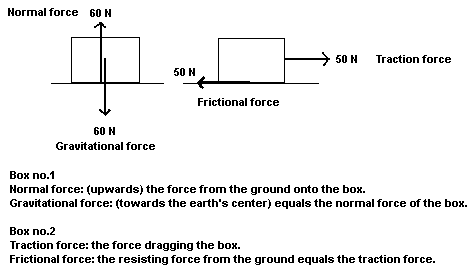
A force can be directed in other directions also. Here are
two forces replaced with a force of 70 N. The dashed lines
are drawn to help when you draw the replacement force.

Describe the relationship between mass and
weight and the
units kilogram and Newton?
The mass describes how much matter an object has. Mass has
the unit kilograms (kg). The weight of the mass is the
attractive force towards the earth’s center. A certain mass
thus has a certain attractive force towards the earth’s
center.
![]()
G = gravity, attractive force, weight, gravitational force
(unit specified in Newtons (N))
m = mass (kg)
g = gravity coefficient (m/s2) = 10 m/s2 on Earth (Jupiter
has approx. 25 m/s2)
Calculate with the formula above, how much weight your mass
has on earth.
Describe the
attractive force between the moon and earth?
All masses are attracting each other. Earth affects the moon
with a certain attractive force. The moon affects earth with
the same attractive force. It is always a force holding
back; otherwise the moon would be slung into space. This
type of attractive force is called gravity.

What is leverage and when is it used?
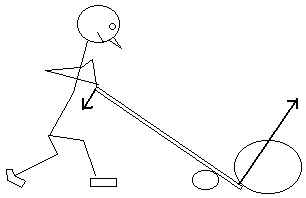
With the help of a lever you can move large stones. A
gearbox in a car is also based on leverage. Small gearwheels
pull bigger gearwheels, which gives greater force.
What is a dynamometer?
A dynamometer measures forces.
![]()
The greater the force pulling the hook, the greater the
force shows on the graduated scale in the tube. Get a
dynamometer and test what forces that may arise. A
dynamometer is often also graduated in grams (mass).
What is the center of
gravity?
An object's center of gravity is the point where we can say
all its mass is concentrated. An iron ball has its center of
gravity in the middle. When balancing a pen on your finger
the center of gravity is just above your finger, centered in
the middle of the pen. Below are shown center of gravity
points in two figures. Note that although figure 1 is a
cylinder, its center of gravity is in the middle of the
volume.
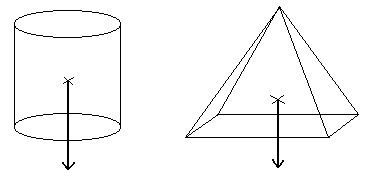
Figure 1 Figure 2
If you tilt a geometric figure the attractive force
(gravitational force) from the center of gravity wanders
outside the object’s supporting surface. When this happens
the object overturns by itself. Place a milk carton on a
table and start tilting it until it is overturns by itself.
When this happens the center of gravity is outside the
supporting surface.
Who was Isaac Newton?
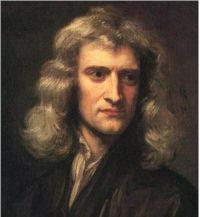
Isaac Newton lived in England from 1643 to 1727. He studied
the gravitational force and named its unit (Newton). It is
said that Newton began investigating the laws of gravity
when seeing an apple falling from a tree.
Describe the relationship between pressure,
force and area?
What units are there for pressure?
Formula: P = F / A
P = Pressure (unit: Pa or N/m2)
F = Force (N)
A = Area (m2)
The unit of pressure is Pa (Pascal). Pressure is also
measured in "bar", "atmospheric pressure" and "millimeters
of mercury”. Pressure means that a certain force works on a
given area.
Why use snowshoes?
A person's weight is held up by an opposing equal force
working from below and upwards on the sole of the feet. All
weight (force) is distributed on the feet sole areas. If the
area is larger, it means that the pressure against the
surface becomes smaller. In this way a man with snowshoes
does not sink so deep in the snow. Look at the formula
above. Insert a larger area in the formula and see what
happens with the pressure.
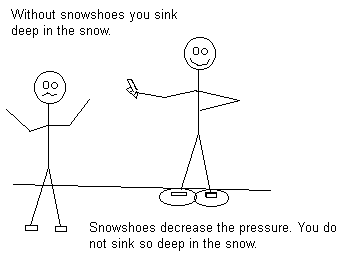
Describe atmospheric pressure,
overpressure, underpressure
and vacuum. Give examples?
Air pressure:
The air (including nitrogen, oxygen, etc.) that exists above
the earth’s surface has a certain mass. The mass has a
certain gravitational force (weight) on earth. The air total
weight on one square meter on Earth's surface generates a
pressure here. This pressure is called one atmospheric
pressure or one bar. An atmospheric pressure weighs as much
as a ten-meter high column of water. Which is the amount of
one atmospheric pressure expressed in Pa?
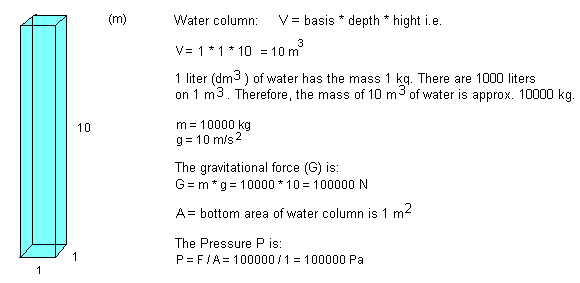
One atmospheric pressure or one bar is according to the
above calculation 100 000 Pa.
Overpressure
If you pump air into a closed tin the air pressure increases
in the tin. The pressure here is higher than outside the
tin. It is an overpressure in the tin.
Underpressure
If air instead is sucked out of a closed tin, the pressure
inside the tin is lower than outside the tin. It is an
underpressure in the tin.
Vacuum
If air is sucked out of the tin until no air remains, it is
a vacuum in the tin. In space there in no air at all. This
means we have a constant vacuum in space.
The Magdeburg
hemispheres
Otto van Guericke (1654) showed a famous experiment. He made
two hemispheres of metal that just fit into each other. Otto
invented an air pump that sucks out air from the created
sphere. Eight horses (different data of how many) were
connected to one hemisphere and eight horses to the other.
The horses tried to pull apart the sphere. The negative
pressure (underpressure) existing in the sphere was so big
that the sphere could not be divided despite all
horsepowers. The reason was that the air pressure outside
the sphere was bigger than the inside pressure. The air
outside the sphere squeezed the hemispheres (ball halves)
together with such force that they could not be divided.
This way it was shown that the air pressure we humans are
staying in is quite big.

What is a Barometer?
A barometer measures air pressure.
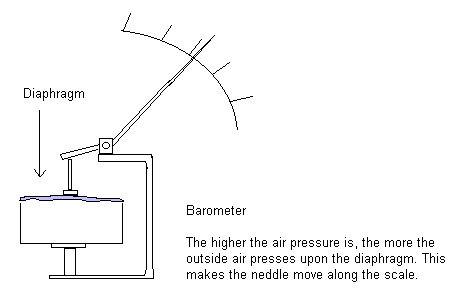
What happens to a trapped gas if its
temperature is
increased?
If instead a balloon is heated, the balloon will grow is
size, since the air pressure inside the balloon would be
bigger. Keep in mind that it is always a counterpressure
holding back as the balloon gets bigger.
Questions
1.
Calculate the weight (attractive force) of your mass on
earth?
2.
Place a milk carton on a table and start tilting it until it
overturns by itself. Do the same when the milk carton is
lying down. How can you do to get its center of gravity?
3.
Get a dynamometer and test what forces can occur?
4.
Give examples of where we have positive pressure
(overpressure) and negative pressure (underpressure)?
Copywrite NGU, Northern Pontifical Academy 2025 (A.I.C.)